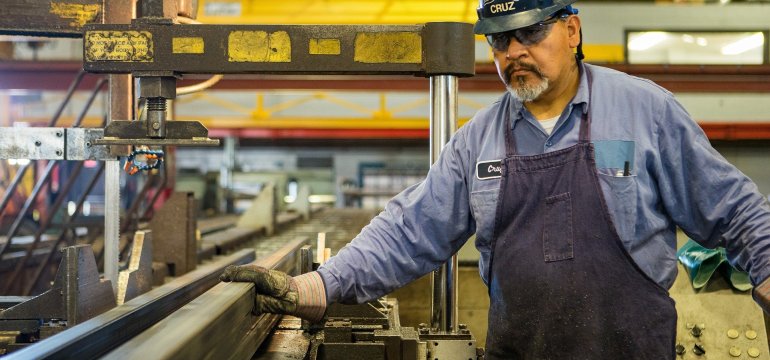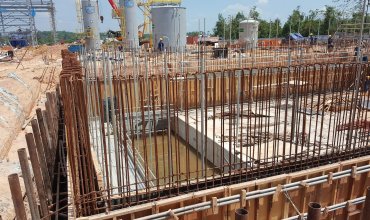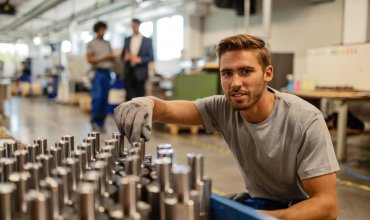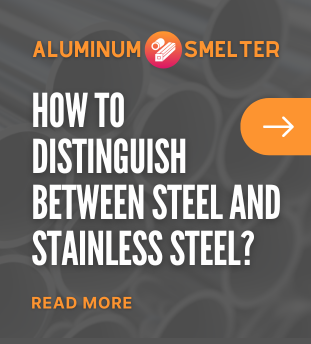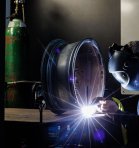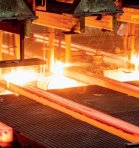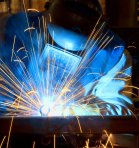Steel is one of the most important materials used in the construction industry, automotive industry or even in everyday household items. Due to its unique mechanical and chemical properties, steel is held in high regard around the world, displacing many other materials. If you've ever wondered what steel is made of, this article is for you. We will answer this question by looking at the chemical composition of steel and its various types, applications and production methods. We will also look at Poland's role in the global steel industry.
What is steel?
Steel is an alloy of iron with carbon and other elements that give it unique functional properties. Although iron is the main component of steel, its content in a particular steel is not the only factor determining its properties. Normally, the carbon content of steel ranges from 0.02% to 2.1% by weight, but the addition of other elements such as chromium, nickel, manganese and molybdenum also affect its properties.
Physical properties of steel
Steel is characterized by high tensile strength, hardness and corrosion resistance in the case of stainless steels. With the right choice of components, it is also possible to obtain a material that is resistant to high temperatures and erosion. All this makes steel an extremely versatile material.
Chemical composition of steel
When analyzing what steel is made of, we focus on its chemical components. Iron (Fe) is the basic element of steel. As mentioned earlier, the addition of carbon (C) significantly affects the hardness and strength of the material. However, for steel to have its characteristic properties, the presence of other elements is also necessary.
Iron
Iron, as the main component of steel, forms its base. It is a metal of relatively low hardness in its pure state, but with admixtures it becomes strong and resistant to various forms of stress. Iron is readily available in the earth's crust, making it a cheap and practical material for steelmaking.
Carbon
Carbon is a key component of steel that determines its hardness and strength. Depending on the percentage of carbon, different types of steel can be obtained, from low-carbon (max. 0.3% C) to high-carbon (above 0.6% C). Carbon reacts with iron to form cementite (Fe3C), which gives the steel its mechanical properties.
Alloying additives
Other additives, such as chromium (Cr), nickel (Ni), molybdenum (Mo) and manganese (Mn), are added to improve the properties of the steel. Chromium, for example, increases corrosion resistance, while nickel improves strength and hardness. Molybdenum adds heat resistance to the steel, while manganese affects its flexibility and wear resistance.
Chromium
Chromium is particularly important in the production of stainless steel due to its ability to form a passive chromium oxide layer on the surface of the steel, which prevents corrosion. Typical chromium content in stainless steel ranges from 10.5% to 13%.
Nickel
Nickel is another important additive that improves the corrosion resistance and structural stability of steel, especially in chemically aggressive environments. Nickel-containing steels are often used in the chemical industry and in the manufacture of equipment operating under considerable stress.
Manganese
Manganese acts as a deoxidizer, removing oxygen and sulfur from the steel solution and improving its strength and hardness. Typical manganese content in steel ranges from 0.25% to 2%.
Molybdenum
Molybdenum significantly increases the steel's resistance to high temperatures and corrosion. It is often used in steel for boilers, pipes and other components exposed to high temperatures and aggressive environments.
Steel production - from mine to finished product
Steel production is a complex process consisting of many stages, from the mining of iron ore, through its processing, to the manufacture of the finished product. Poland, as one of the European leaders in steel production, has a well-developed industrial infrastructure.
Iron ore mining
The first stage of steel production is the mining of iron ore. The ore is then transported to steel mills, where it is processed into pig iron. In Poland, the best-known iron ore mining region is the Dąbrowa Basin.
The blast furnace process
Blast furnaces are the heart of any steelmaking plant. Raw iron ore is processed there into pig iron, using coke as fuel. The process involves the reduction of iron oxides to metallic iron, which is made possible by high temperatures (about 2000°C).
Manufacturing crude steel
The next stage is the transformation of iron pig iron into crude steel. This is done in oxygen converters or electric arc furnaces, where various alloying elements are added to the pig iron to produce steel with the desired properties.
Rolling and forming
Once the crude steel is obtained, the material is subjected to further processes such as hot or cold rolling, forming, as well as various heat and chemical treatments to obtain finished products with specific parameters.
Types of steel and their applications
Steel is an extremely versatile material, and its different types have their own unique applications in various industries. Here are some of the most important types of steel and their applications:
Carbon steel
Carbon steel is the simplest and most commonly used type of steel. It can be divided into three categories: low-carbon, medium-carbon and high-carbon. Low-carbon steel (containing up to 0.3% carbon) is often used in construction and the manufacture of structural components. Medium-carbon steel (0.3%-0.6% carbon) is used in the manufacture of mechanical equipment, while high-carbon steel (above 0.6%) is used in the manufacture of tools and accessories requiring high hardness.
Stainless steel
Stainless steel contains at least 10.5% chromium, which gives it exceptional corrosion resistance. Thanks to its properties, stainless steel is used in the manufacture of kitchen and medical equipment and in the chemical industry. It is also a popular material in architecture and construction, where aesthetics and durability are key.
Tool steel
Tool steel is a special type of steel that is characterized by exceptional hardness and sharpness. It is used to make tools, dies and molds. Tool steel usually contains additives such as vanadium, molybdenum or cobalt to improve its mechanical properties.
Structural steel
Structural steel is used in construction, where strength and durability are key. This type of steel is used for bridges, towers, ships and residential and commercial buildings. It contains the right proportions of carbon and alloying additives to give it optimal mechanical properties and durability.
Special steel
Special steel contains additional alloying elements and is used in specific applications requiring unique properties. An example is maraging steel (a high-alloy steel with added nickel and cobalt), which has exceptional strength and is used in aviation and in the manufacture of sports equipment.
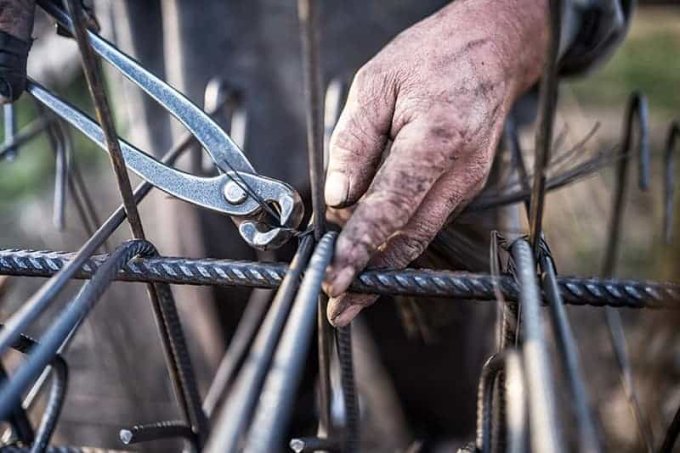
Poland's role in the steel industry
Poland plays a significant role in the European steel industry. The country has a number of steel mills and processing plants that produce various types of steel, both for domestic use and for export.
Polish steel mills
Poland is home to such powerful plants as Huta Stalowa Wola, Huta Katowice and ArcelorMittal Poland. These plants not only produce steel, but also invest in modern technologies that increase the efficiency of production and reduce its impact on the environment.
Ecology in steel production
The modern steel industry also places great emphasis on the ecological aspects of production. Poland, as a member of the European Union, is obliged to comply with strict environmental standards. As a result, Polish steel mills are investing in technologies that reduce CO2 emissions and in raw material recycling programs.
Economic importance
Steel production is of great importance to the Polish economy. It employs thousands of people in various regions of the country, which contributes to regional development. In addition, Polish steel exports are an important part of the country's trade balance.
Importance of steel in everyday life
Steel is present in many aspects of our daily lives, although we are often not aware of it. From infrastructure construction to household appliances to modern electronic devices, steel is ubiquitous.
Construction
Residential buildings, shopping malls, skyscrapers and bridges - all of these structures could not exist without steel structural components. Steel is the primary nodal material in construction. Thanks to its strength, it allows even the most daring architectural designs to be realized.
Automotive industry
Cars, buses, trains - steel is an integral part of the construction of each of these means of transportation. The appropriate use of various steel alloys makes it possible to increase vehicle safety and efficiency. It is not only a structural material, but also an element of the vehicle interior, for example, in the form of decorative elements.
Domestic equipment
Thanks to its resistance to corrosion, stainless steel is a popular material in kitchens - in the manufacture of sinks, pots, cutlery and other kitchen accessories. Also, modern refrigerators, stoves and washing machines often contain stainless steel components, ensuring their longevity and aesthetic appearance.
Electronics
Many do not realize that steel is also an important component in the manufacture of electronic devices. The casings of computers, televisions and even smartphones are often made of steel, which protects them from mechanical damage and increases their durability.
History of steel in Poland
Poland has a long and rich tradition in steel production, dating back as far as the 19th century. The first steel mills were established in what is now Poland in response to the growing demand for steel in industry and construction.
First steel mills
Some of the first steel mills in Poland were located in Silesia and Malopolska, where the material was essential to the growing mining and metallurgical industries. As time passed, more plants were established to meet the growing demand for steel.
Development in the 20th century
In the 20th century, especially after World War II, the steel industry in Poland experienced rapid development. New plants were being built and old plants were being modernized, allowing production capacity to be significantly increased. During the communist period, steel mills were a key element of the 5-year plan to rebuild the country and achieve industrial development.
Transformations of the 1990s and 21st century
After the political transformation in 1989, the Polish steel industry faced many challenges in adapting to international standards and competing with foreign countries. Thanks to investments in modern technologies and plant restructuring, Poland has managed to maintain its position as an important player in the European steel market.
Challenges and the future of the steel industry
Although steel is a material with numerous advantages, the steel industry faces several challenges that will affect its future in the coming years.
Ecology and sustainability
One of the main challenges is the need to adapt to increasing environmental requirements. Steel production is an energy-intensive process, generating significant amounts of carbon dioxide. As a result, the industry must constantly look for new production methods that minimize the negative impact on the environment.
Technological innovations
Modern technologies such as steel recycling, the use of biofuels and the development of advanced steel alloys can make a significant contribution to the sustainability of the steel industry. The introduction of automation and digitization of production processes can also increase the efficiency and quality of manufactured products.
Competition with other materials
Steel as a construction material has to compete with other modern materials, such as composites and plastics. Although steel still has an advantage due to its strength and durability, continuous innovation is necessary to maintain its position in the market.
Summary
Steel is an extremely versatile and widely used material that plays a key role in many industries. What steel is made of - is a question that has a multifaceted answer, depending on the type of steel and its purpose. Poland, with its rich tradition in steel production and modern technologies, faces the challenge of adapting its industry to modern environmental and technological standards. With innovation and investment in modern technologies, the steel industry has a chance to continue to grow and maintain its key role in the global economy.
In our daily lives, steel plays an irreplaceable role, whether it is the structure of a bridge, the car we drive or even the kitchen tools we use. Understanding what steel is made of is key to appreciating its importance and the role it plays both in the past and in the future.


